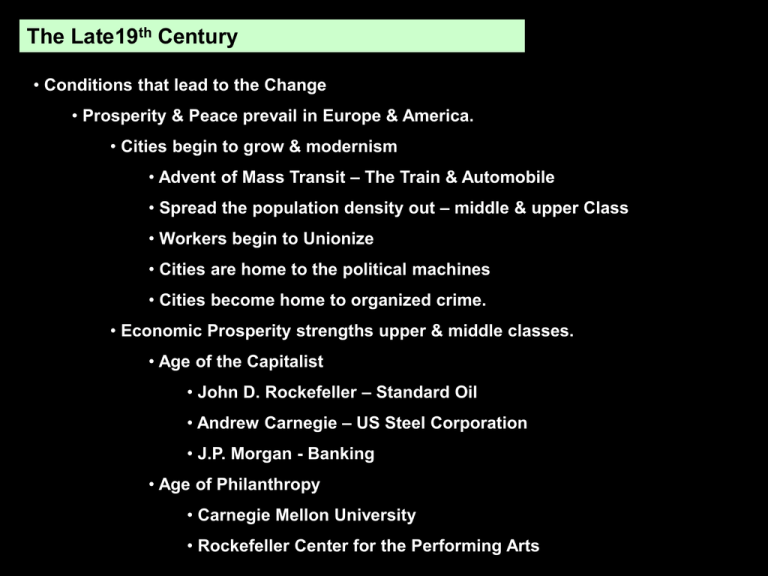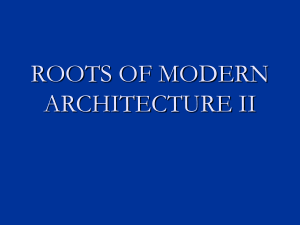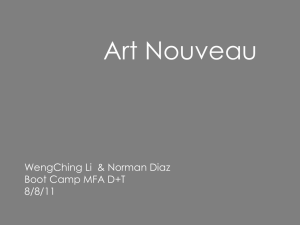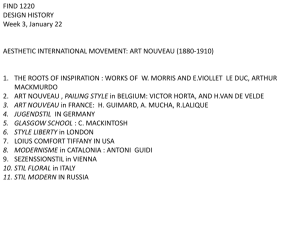The Art Nouveau Hector guimard (1867
advertisement

The Late19th Century • Conditions that lead to the Change • Prosperity & Peace prevail in Europe & America. • Cities begin to grow & modernism • Advent of Mass Transit – The Train & Automobile • Spread the population density out – middle & upper Class • Workers begin to Unionize • Cities are home to the political machines • Cities become home to organized crime. • Economic Prosperity strengths upper & middle classes. • Age of the Capitalist • John D. Rockefeller – Standard Oil • Andrew Carnegie – US Steel Corporation • J.P. Morgan - Banking • Age of Philanthropy • Carnegie Mellon University • Rockefeller Center for the Performing Arts The Late19th Century • The Industrial Age has taken root •People are afford Choices of products • People like Marshall Fields develop mail order stores • People can go off the shelf rather than make their own • People Oppose the Past •No more classical ornament • John Ruskin’s – 7 lamps of Architecture • also against modernism • Believed everything should be hand crafted • Lead to Arts & Crafts Movement •Desire to be different & New • Better understanding of Nature • Look toward the Future ( I.e. Science Fiction) • New Artistic Expression • Lead to Art Nouveau Period. The Arts & Crafts Movement • Philip Webb • Red House (1859 -1860) Designed for his boss, noted furniture designer, William Morris, this simple space was designed in the arts & crafts style. The austere walls painted white were merely a backdrop to the Settle, the bench/cabinet unit designed by Morris. The hinges were hand cast & painted. Red House – sitting room The Arts & Crafts Movement • Philip Webb • Standen (1891 -1894) Again full of Morris designed furniture, Cabinets & rugs. The white painted paneling is typical of the arts & crafts movement. The house itself is designed in a cluster arrangement meant to have the character of a Farm house. Its focus is simplicity Standen – drawing room The Arts & Crafts Movement • Edward Ould • Wightwick (1887 -1893) This space was designed to feature the products of Morris & Co. The linen wall covering, rugs & chair were all products made by Morris. The mantel & fireplace were designed & milled by Ould. Wightwick – sitting room The Arts & Craft Movement • Thomas Jeckyll & James McNeill • The Peacock Room (1876 -1877) Designed to house Japanese Porcelain, the room is blue & gold. The room was painted to mimic the feathers of a peacock. The handcrafted shelving stretches from floor to ceiling. The ceiling is treated with gothic revival wood ornament but now incorporates light fixtures, making them distinctly of the arts & crafts movement. The Peacock Room The Arts & Crafts Movement • Charles Francis Voysey • Chorley Woods (1900) This simple living space starts to jump toward modernism with its simplicity. Voysey designed the carpets, wallcovering & the furniture for the space. The space & furniture fit each other in its simplistic forms. Chorley Woods - Hall The Arts & Crafts Movement • Charles Rennie Mackintosh (1868-1928) • Hill House (1902 -1903) Mackintosh was the embodiment of the relative styles at the end of the late 19th Century/ early 20th Century. His designs incorporated elements of both the arts & crafts movement as well as Art Nouveau. He completely shunned any historicism in his work. He work even hints toward early modernism with its strict geometries. The designers of the arts & crafts period not only were responsible for the spaces they created but also the furniture & fixtures. Mackintosh is widely known for his furniture designs. He often used simple geometries & then exaggerated the features to provide a level of creativity. Mackintosh was one of the founding member of the Glasgow School of Art – a very influential school dedicated to progress. Hill House – Living Room The Arts & Crafts Movement • Henry Hobbs Richardson (1838-1886) • Trinity Church (1887) Richardson’s architecture is often considered the Romanesque Revival. The exaggeration of the arched forms and the creation of double archways is a distinct break from the past & are expression by Richardson. The church was highly colored with painted stenciling & tiffany Windows. Trinity Church - Exterior Trinity Church - nave The Arts & Crafts Movement • Henry Hobbs Richardson (1838-1886) • Marshall Fields Warehouse Store This building used huge arched windows to bring in the natural light. The building filled the footprint of the entire block. The interiors were simple loft warehouse spaces. timber columns & wood plank flooring. The real character of the building was its exterior. The original building burned down in the great Chicago fire. The building was torn down for a parking lot in 1931. Marshall Fields - Exterior The Arts & Crafts Movement • Charles & Henry Greene • Gamble House (1908) Based on Japanese woodwork design, the house uses mahogany, teak & rosewood. The stained glass windows bring in blues, greens, and reds. The Greene brothers were masters of wood joinery. The carefully crafted details add a layer of sophistication to the design. Gamble House - entry The Art Nouveau • Eugene Vallin • Masson House (1903 - 1914) Vallin designed every detail in the library. The organic nature of the ornament creates the character. In the Art Nouveau movement, organic & curvilinear forms become prominent & exaggerated. The forms copy those of nature as well as abstract forms. Art Nouveau resulted in the combination of sculpture & architecture. It was the rejection of both the Gothic & Classicism. It highlighted modern materials & Color. Masson House – Dinning Room The Art Nouveau • Victor Horta (1861- 1947) • Tassel House (1892) Victor Horta was one of the best architects of the period. In the Tassel House, he used very thin metal work in combination with elaborate tile patterns, in effort to bring out the organic curves. The walls were cream colored with stenciled patterns painted over the top. In the Art Nouveau, there was an acceptance of metal as a construction material. Its fluid nature allowed for complete flexibility. Tassel house - stair The Art Nouveau • Victor Horta (1861- 1947) • Horta House (1898 - 1911) Horta used all different kinds of tile on the walls, ceilings & floors. He balanced the cool expression of the tiles with wood. Stained glass was used to bring in color to individual rooms. The furniture of the period was made up of curving wood pieces. Very skeletal. The furniture expressed the curve and mimicked the designs of the times. Horta house – Dining Room The Art Nouveau • Hector guimard (1867- 1941) • Castel Beranger (1894 - 1899) Guimard is used a combination of Terra Cotta tiles & metal to create the unique character of the space. He stenciled over the ceiling with floral elements. Most colors were in the pastel range, a commonality in most Art Nouveau work. Guimard better than anyone else worked with metal & its fluid nature. Castel beranger – entry The Art Nouveau • Hector guimard (1867- 1941) • Paris Metro kiosks (1900) The most iconographic design of the period. Guimard used a combination of metal & decorative glass , to create forms of nature. A number of these kiosks were built around Paris, all of similar design. The more prominent locations received unique designs. This design has been mimicked all around the western world. It has become inherently Parisian. There is even a building on Dearborn in Printers Row in Chicago that directly copies this in its façade. Porte Dauphine – entry The Art Nouveau • Antonio Gaudi (1852 - 1926) • Casa Batllo (1904-1906) Gaudi used fluid forms that seem to melt together. On the exterior he uses tiles & Terra Cotta ornament to express this fluid nature. On the interior the buildings ceilings fold down & become walls. The columns take on Skeletal quality. Casa Batllo – exterior Casa Batllo – dining room The Art Nouveau • Antonio Gaudi (1852 - 1926) • Casa mila (1905) Gaudi, similar to Casa Batllo, used fluid forms that seem to melt together. On the exterior, you see sculptural chimneys atop the fluid curving roof. On the interiors are derived more organically. Their chaotic nature and bubble like forms are almost other worldly. Casa mila – exterior Casa mila – plan The Art Nouveau • August Endell (1867- 1941) • Elvira Studio (1896) Endell took the lead in the Jugendstil which was centered in Munich and started in 1869. The Jugendstil mirrors the Art Nouveau period. IN the atelier Elvira, Endell used forms of water & animals ( fish fins) to create the elaborate bas relief façade. The elements create a sense of whimsy & fantasy in trying to portray an undersea world. Atelier Elvira – entry The Art Nouveau • Peter Behrens (1868 - 1940) • turbinenfabrik (1909) Behrens was a bit of an anomaly. His work is considered by some to be in the Jugendstil but most consider him one of the early modernists. This Turbine Factory is a great achievement in design in that is ceases to be just an industrial building. The office portion of the factory receives decorative treatment. The factory portion mimics classical proportion. A great combination of brick detailing, glass & steel. Behrens was quite influential. At one time in his firm, Walter Gropius, Le Corbusier, & Mies Van De Rohe all worked together as apprentices. turbinenfabrik – exterior & section The Art Nouveau • Lars Sonck (1870 - 1956) • St. Johns (1902 - 1907) The Jugendstil made its way to Scandinavia. Finland adopted the style whole heartedly. It allowed for the creation of Romantic Nordic Design. It works within the styles of the Gothic Revival as well as the Art Nouveau. This church shares similarity to Richardson’s Trinity Church in Boston. The ornamental plaster with Stenciling of floral ornament highlights the interior. St. Johns – Nave The Art Nouveau • Josef Olbrich (1867 - 1908) • Secession Hall (1897) The Vienna Secessionist were architects, designers & Painters who had left the Vienna Academy in 1892 led by artist Gustav Klimt because the school refused to accept modern practices. Secessionist Hall became their guild. The symmetrical building hints at classicism & rococo. The gilded ornament ( leaves & theatrical masks of Medusa) on the exterior makes it part of the Art Nouveau. Secession Hall – Exterior The interior has a series of stenciled squares painted on the plaster. There are also murals depicting fantastic scenes of nature. Secession Hall – Grand Hall The Art Nouveau • Otto Wagner (1841 - 1918) • Post Office Savings Bank (1904 - 1906) Wagner’s work over his career spanned from revivalism to the modern. This bank in Vienna combined glass, steel, & brick. The elaborate stone tile floors richly colored & glazed bring a level of glint to the space. The glass barrel vaulted ceiling allowed created a milky cloud of light from above. The steel Rivets were made to be decorative as to not miss an opportunity. Savings Bank – Banking Room The Art Nouveau • Josef Hoffmann (1870 - 1956) • Palais Stoclet (1905 - 1911) Hoffmann’s work mixed ideas of early modernism, the art Nouveau & the Secessionist movement. He was a founding member of the Werkstatte – an Arts & Crafts guild. The walls are comprised of richly veined marble. The floors are ceramic tiles. The furniture is very strict & boxy a la the modernist movement. The paintings on the wall are of the Art Nouveau style. Palais Stoclet – Dining Room The Art Nouveau • Adolph Loos (1870 - 1933) • Loos Residence (1903) Loos, like Hoffman, was of an eclectic mix. He was an early modernist who made forays into the Art Nouveau. His work was very geometric. He exposed materials to bring their tactile qualities into the space. He built in shelving & cabinets so that the design housed the function & didn’t need to be dressed up with furniture. Loos Residence – Living Room The Art Nouveau • Louis Comfort Tiffany (1848 - 1933) • Tiffany Residence (1883-1884) Tiffany produced everything from windows, vases, bowls, to lamps & paperweights. His work included floral motifs. He produced stained glass for churches such as Richardson’s Trinity Church in Boston. The walls in his residence were decorated with floral patterned wall covering. The Residence was the predecessor to the American Art Nouveau. tiffany – window tiffany Residence – Living Room The Art Nouveau • Louis Sullivan (1856 - 1924) • Auditorium Theater (1886-1890) Sullivan along with Adler & Burnham were the fathers of the Chicago School. Their designs influenced the nation. The Auditorium done by Sullivan was an opulent jewel. It was richly colored with painted detail & painted terra Cotta Panels. The intricate panels line the beams & the proscenium. Sullivan designed the ceiling such that it was moveable to minimize it for lesser crowds. This meant the space was acoustical superior to any other in the USA. Auditorium Theater – Main Hall The Art Nouveau • Louis Sullivan (1856 - 1924) • Guaranty Building (1894) Sullivan’s designs match those of the Art Nouveau as well as modernism. They are very organic and layered. The abstract natural forms heighten the level of scale within the space. The ornament was either produced in metal or in cast Terra Cotta. His buildings became framework from which he could display his ornament. Sullivan is known for the statement, “form follows function.” Sullivan was also the mentor to Frank Lloyd Wright. Eventually, with the advent of modernism and the popularity of his pupil, Wright, he drank himself into oblivion. Guaranty Building – Ornament





